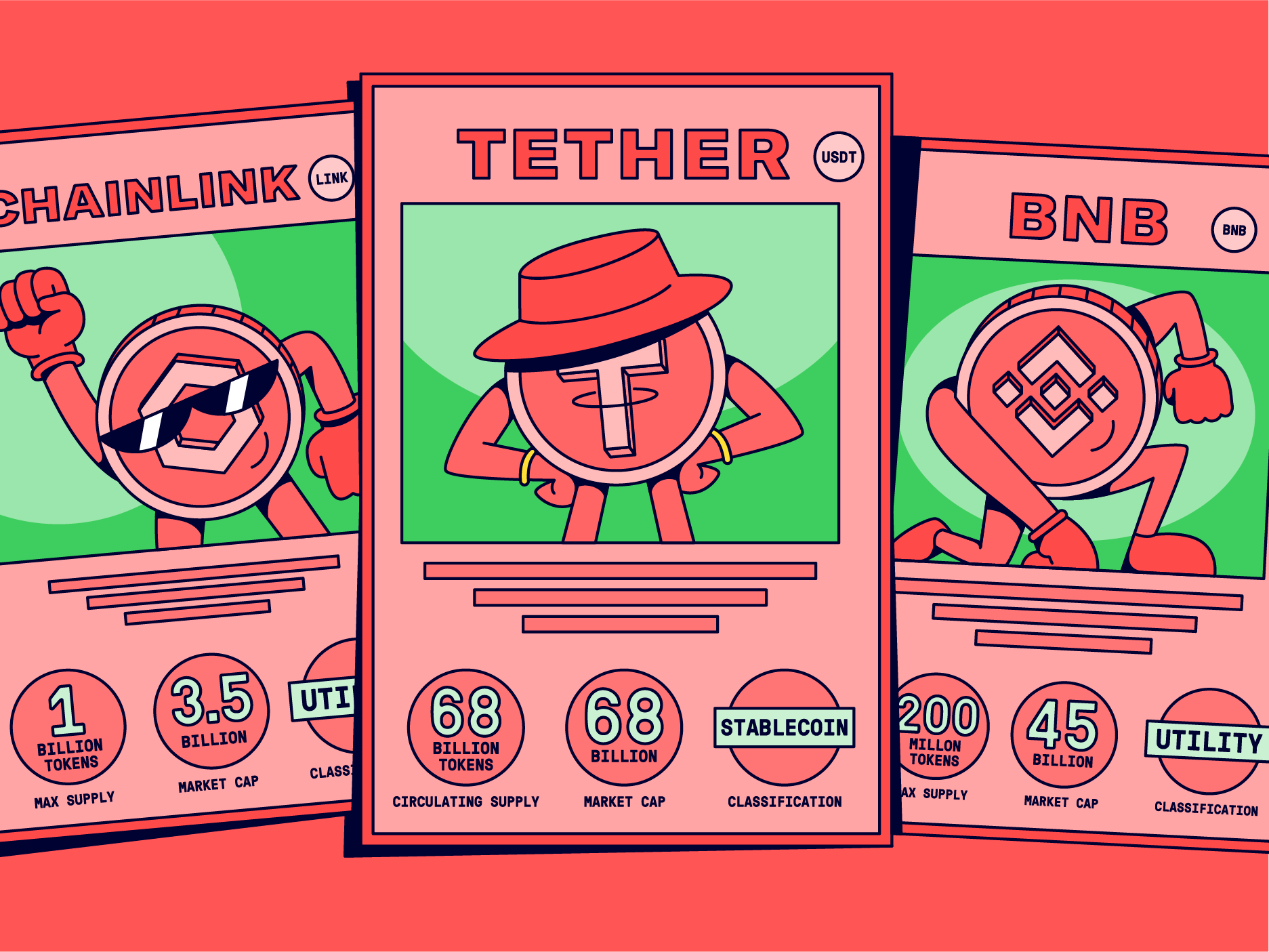If you’ve ever come across tokenomics when researching crypto projects only to realize you have no idea what it is, this article is for you. From supply and distribution to minting and burning, learning these essential concepts will make you a better crypto investor.
Where Did Tokenomics Come from?
The term “tokenomics” is derived from “token economics”, otherwise known as the economics of a cryptocurrency.
From its supply to its initial distribution among early investors, tokenomics encompasses multiple cryptocurrency features. It may also represent the practical applications of a coin or token (i.e. its utility or use cases).
Key Features of Tokenomics
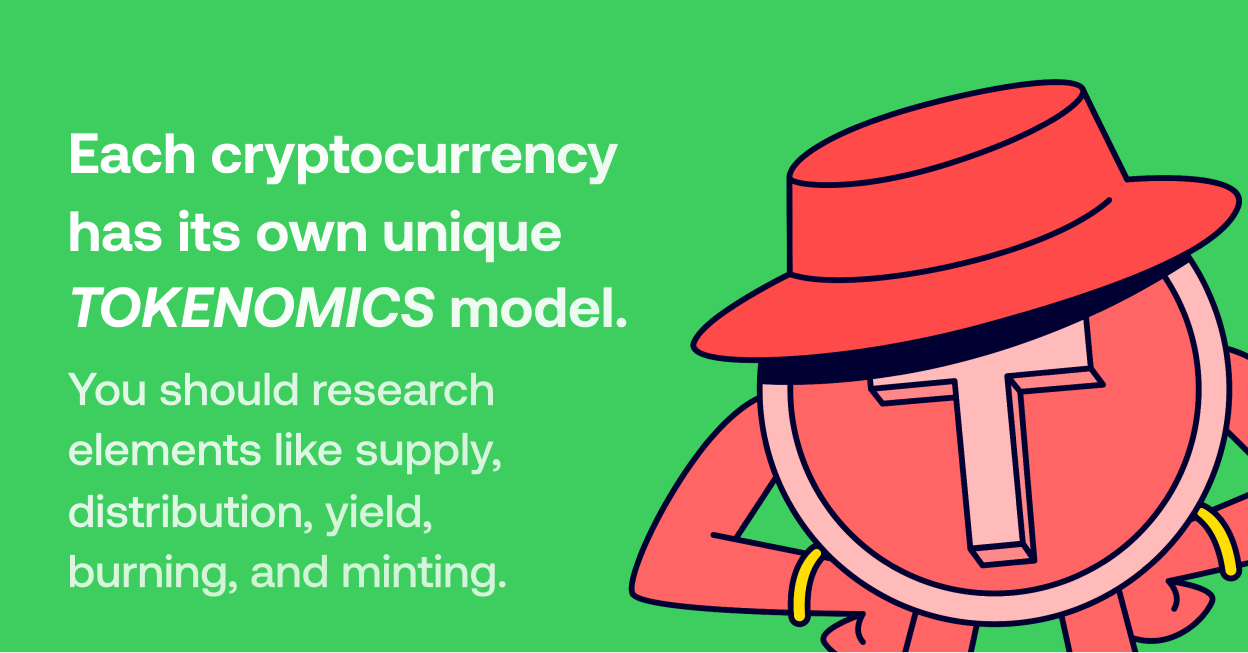
Seeing how tokenomics represents the “economics” of a token, listing each aspect would be impossible. Many cryptocurrencies also introduce their own unique tokenomics models. However, there are key economic “foundations” for every project:
1. Supply
One of the first things investors tend to look at when assessing a project’s tokenomics is its supply.
Max Supply
The maximum supply of a cryptocurrency represents all of its coins or tokens that will ever exist. It’s used to calculate the fully diluted market cap.
Total Supply
The total supply of a cryptocurrency is the number of coins or tokens that have already been released/minted, including all burned tokens.
Circulating Supply
Finally, the circulating supply represents the current amount of coins or tokens in circulation on the open market.
2. Distribution and Vesting
When projects launch, they often go through various rounds of investments. Depending on the round, investors purchase tokens at different price levels. These rounds can be private (ie. only for select investors) or open to the public.
Depending on when a cryptocurrency was purchased, the owner’s funds could be locked up (ie. unable to be sold) for a period of time known as a vesting period. This is often done for early investors who receive preferential prices. Usually, these lockups are lifted gradually, allowing investors to sell some of their holdings.
Some crypto projects launch without any preliminary rounds. These are known as “fair launches” and they’re open to the public.
3. Market Capitalization
While it’s rarely the most important tokenomics metric, market capitalization (also called market cap) is often the first element you’ll come across when researching projects.
It’s a straightforward indicator that represents the current price of a cryptocurrency when it’s multiplied by its circulating supply. The market cap is a good way to gauge the size of a project.
How Liquidity Pool Sizes Affect Market Cap
On some decentralized exchanges (DEXs), instead of trading between themselves, users trade through a pool of assets, also known as a liquidity pool. This can occasionally distort our perception of a token’s value. For example, because they’re heavily influenced by large transactions, small liquidity pools lead to volatile token prices. When it comes to insufficient liquidity pools, even a relatively small purchase might lead to a major spike in token price (increasing its market cap in the process).
Whenever you trade on Automated Market Maker-based DEXs, consider the liquidity pool size as well as the liquidity-to-market cap ratio: Anything above 10% is considered to be highly liquid.
Fully-Diluted Market Cap
This is the market cap of a cryptocurrency if its max supply is in circulation. This metric is primarily used to evaluate the potential future price of an asset. Because of elements like vesting schedules and inflationary tokenomics, circulating supplies can change. Sometimes they increase and other times all of a project’s tokens enter circulation.
The fully-diluted market cap can be used to understand how much more demand there needs to be for a cryptocurrency to remain at the same trading price (in a scenario where its whole supply enters circulation).
4. Tokenomics Model (Inflationary and Deflationary)
A crypto’s model is a part of its tokenomics. Put simply, any cryptocurrency can be inflationary or deflationary, based on what happens to its circulating supply:
If the crypto’s supply increases, we can say it “inflates”. Currencies with supply increases are known as “inflationary”. If demand for them remains the same their price will decrease over time.
If the supply decreases, it’s said to “deflate.” Should the demand remain the same, the prices will rise. These cryptocurrencies are referred to as “deflationary”.
5. Yield
Yield is cryptocurrency that’s given to holders as a reward for performing different actions. A common way to generate yield in decentralized finance (DeFi) is liquidity mining (or contributing tokens to liquidity pools for profit.)
Staking rewards for blockchain validators can also be considered a form of yield, though the term is more often associated with DeFi.
6. Burning Mechanisms
Token burning is the act of permanently removing crypto tokens from circulation. Deflationary tokens rely on burning to reduce their circulating supplies. This can be achieved by sending the tokens to a “burn address.” Think of it like a wallet that can’t be accessed and can never sell or transfer its tokens. Once they’re sent to a burn address, they can’t be recovered.
People often expect that when a burn happens, the price of the token will immediately jump upwards. This assumption is misleading: While the price will go up if demand stays the same or increases, it won’t happen immediately.
Asset prices are constantly being established on the open market by so-called market makers (ie. traders offering to buy/sell a cryptocurrency). It understandably takes time for the market to react and adjust the price in response to supply reduction.
To understand how markets agree on asset prices, check out our article on slippage in crypto.
7. Minting
Minting refers to the creation of new coins and tokens. When tokens are minted, they’re added to the cryptocurrency circulating supply. Many blockchains (like Bitcoin and Ethereum) mint new coins via mining or staking. Tokens on the other hand are minted by smart contracts (programs running on the blockchain).
Tokenomics of Coins and Tokens
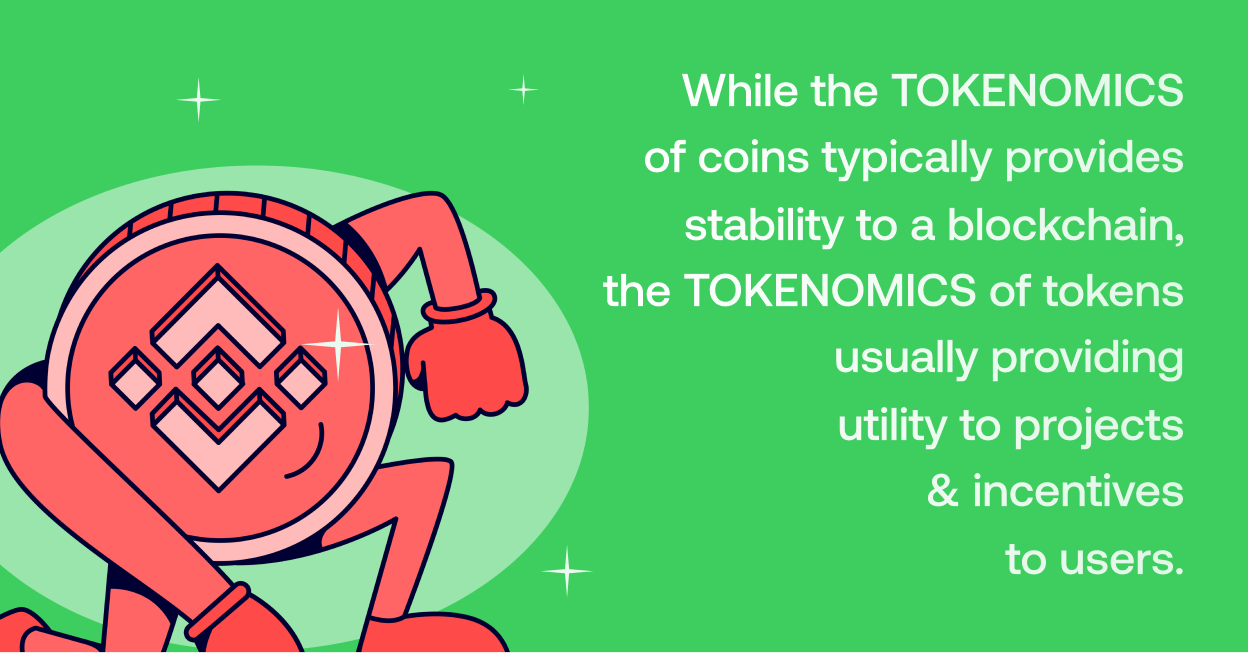
Coins and tokens are both cryptocurrencies but, as mentioned, they come from different places. A coin is a blockchain’s main cryptocurrency that’s used to reward validators and miners (ie. the computers running the network).
Tokens are cryptocurrencies issued by smart contracts that run on a specific blockchain. They’re not subject to the same tokenomics as coins.
While the tokenomics of coins is mainly geared towards providing stability and security to a blockchain network, the tokenomics of tokens is more focused on providing utility to projects and incentives to users.
Why Is Tokenomics Important?
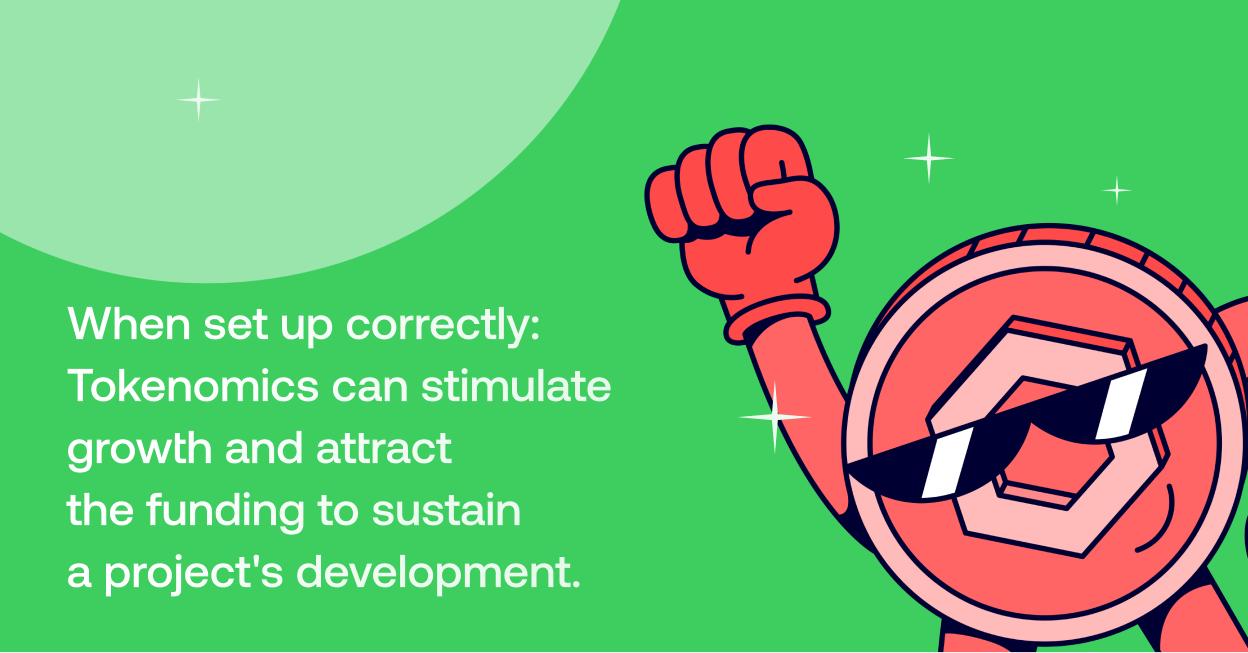
Tokenomics defines the way a crypto-based decentralized system or service functions. It may dictate many of the rules of a blockchain or crypto project’s operation. If set up properly, it can stimulate growth, create a positive feedback loop of growth, and attract the funding necessary for the sustained development of a project.
Conversely, if a project’s tokenomics is set up improperly, it can have disastrous consequences. Consider a giant “vesting cliff.” This occurs when many early investors’ vesting periods end and they’re free to sell their tokens. If enough of them do so simultaneously, they might trigger a massive crash in the price and could derail the project.
Ultimately, successful tokenomics boils down to whether or not it attracts capital and enough users to a network or project.
How Businesses Can Use Tokenomics
By understanding how tokenomics works, businesses should be able to implement the right model for their particular use case. They can acquire capital through investment rounds and initial coin offerings (ICOs), using it to rapidly expand projects.
Moreover, they can appeal to their target user base through a well-planned, incentive structure that’s baked into the products they’re developing.
What Is Bad Tokenomics?
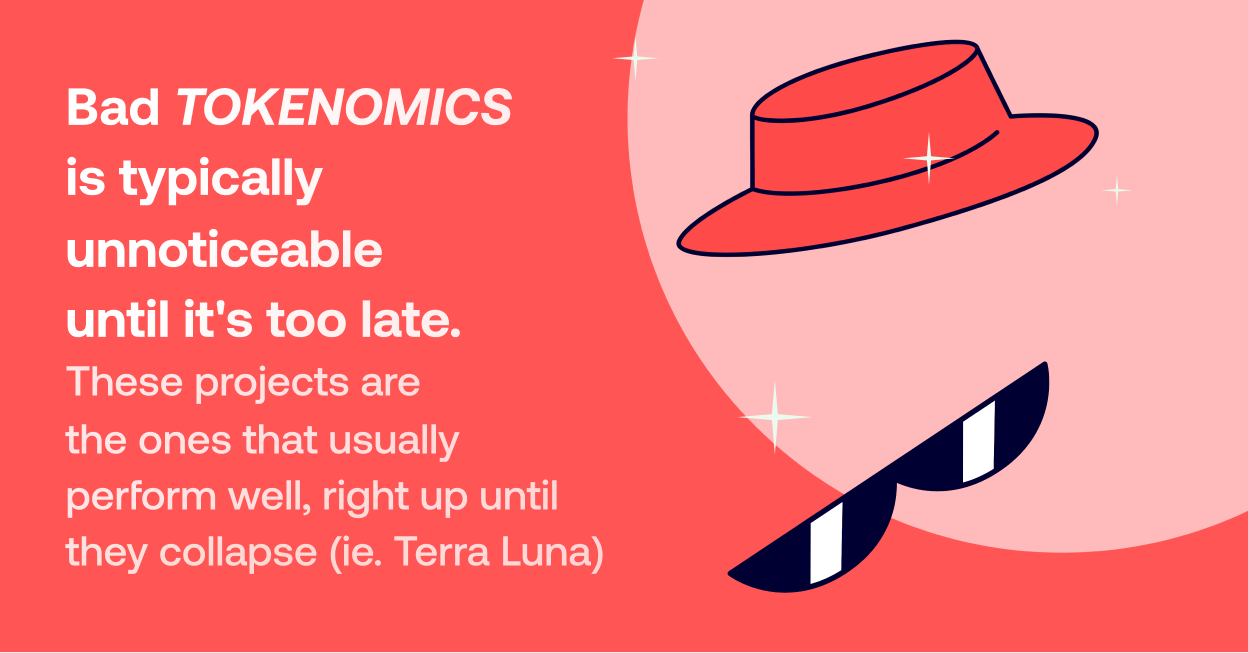
Crypto is an incredibly competitive market with thousands of projects fighting for recognition in a relatively small pool of potential users (at least for now). This is a major reason we see so many interesting tokenomics models appearing every day: Projects are attempting to attract users and secure a foothold in the cryptocurrency landscape.
Most of what tokenomics does is try to influence the mechanisms of supply and demand on the open market.
A project's bad tokenomics is typically unnoticeable until it's too late. These projects are the ones that usually perform the best – right up until they collapse.
LUNA’s Collapse
For example, take the collapse of Terra (LUNA).
LUNA was a cryptocurrency — a counterpart to the algorithmic UST stablecoin, part of the Terra project. The tokenomic setup of this project was based on a “mint-and-burn” mechanism: To secure UST’s peg to the US Dollar, either Luna or UST would be burned to mint the other token. In theory, this balancing act was supposed to stabilize the price of the stablecoin but in reality, it failed, dragging down the entire crypto market with it.
The project was ultimately brought down by a “bank run” (ie. panicked sell-off), resulting in a “death spiral” collapse.
Importantly, the project was one of the most actively traded and talked about projects in the crypto space, right before it failed.
Centralization and Decentralization in Tokenomics
Tokenomics is literally the incentive and economic structure of a cryptocurrency, the design of the token’s economics. Depending on how it is set up, it can lead to either a more decentralized or more centralized product.
If the tokenomics of a cryptocurrency encourages its users to use more decentralized products while engaging in more decentralized practices, it will itself become more decentralized. Conversely, using its incentive structure as a hypothetical example, if a project grants more power to select individual participants, this can lead to more centralization.
How To Assess and Evaluate a Project’s Tokenomics
When considering investing in any cryptocurrency project, it’s recommended to perform what’s known as fundamental analysis (FA). Here, you can gauge a project’s fundamentals, including its core structure, financials, health, main value proposition, competition, and tokenomics.
One of the most important things to consider when analyzing a crypto project is its tokenomics.
1. Examine the Use Case
The first thing you need to ask yourself anytime you’re assessing a project’s viability — and specifically that of its cryptocurrency — is “What is this cryptocurrency’s use case?”
As mentioned, tokenomics exist for two main reasons:
To empower the user of a specific product
To drive the adoption of the product
This first step is pretty straightforward — if you can’t name a current or future use case for the token or coin you’re looking at, it’s probably not a good investment.
A few popular use cases for cryptocurrencies of all kinds include:
Securely transacting value
Securely storing value
Rewarding the miners or validators securing a blockchain
Enabling users to take advantage of a useful product
Rewarding loyal users
Governance
2. Determine the Utility
Once you’ve determined the use case, you can think about the utility (i.e. the actual usefulness of a cryptocurrency). Some cryptocurrencies are more useful than others. For example, without Ether (ETH), the Ethereum network simply wouldn’t be able to function.
An example of the opposite is the token of a DeFi project with a bunch of use cases on paper – but no practical utility. In this case, users aren’t actually finding a use for the token except to speculate with it on the market. No matter how good the use case sounds on paper, if the utility isn’t there, it ultimately means that nobody will actually use the cryptocurrency for the primary reason it was created.
3. Look at the Metrics
Once you have a firm understanding of what a project’s cryptocurrency does, metrics like market cap will make a lot more sense. They provide a stronger idea of how much adoption the coin or token has seen, and can also help you judge its performance and health over time.
4. Understand the Distribution
Projects with big chunks of their supply in the hands of a small group of investors are inherently riskier. Simply through the act of trading, these investors can impact the price and perception around a project.
Investigate who owns tokens from projects you’re looking to invest in. Luckily, crypto is built specifically with transparency in mind: Use blockchain explorer tools like Etherscan and BscScan to analyze wallets and smart contracts to determine who the biggest holders are. Additionally, most of the bigger projects publicly share their token distribution on their own websites. If they don’t, a quick Google search often reveals the third parties who do.
5. Recognize the Cryptocurrency’s Tokenomics Model
Coins and tokens can be either inflationary or deflationary at any given time, and some have built-in tokenomics that automatically switch models once a set of criteria are met. For example, NEAR Protocol adds 5% more NEAR tokens to its supply every year, but it features built-in mechanisms that burn even more tokens during times of heavier network usage. This can turn it from an inflationary to a deflationary cryptocurrency when the network’s being used considerably.
Taking factors like this into consideration will help you form fact-based opinions on how the price of an asset will change in the future if certain criteria are met.
6. Review the Project’s Tokenomics Incentives Structure
Does it incentivize new users to buy and hold the project’s cryptocurrency? Couple this with how useful the cryptocurrency is in practice and you can see its future potential.
The more users a project acquires, the more profitable it’ll become. This will in turn help the project grow and contribute more capital toward developing even better products. If its tokenomics is built out such that the cryptocurrency of the project becomes more valuable to users over time, that’s usually a very positive sign of a healthy project.
How Does Sonar Help you Analyze a Project’s Tokenomics?
Sonar Studio is geared toward DeFi power-users who want to gain an edge on the market by using time-saving tools that help them peer deeper into their investments.
Analyzing projects is a difficult and very time-consuming task, but with Sonar apps like Token Studio, it’s made easy. We provide a streamlined interface built for both beginners and pros where you can see many of the items we discussed in this article, at a glance.
To stay up to date on all things Sonar, subscribe to our newsletter using the form below.
